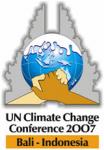Climate Change and the UN: What COP 13/MOP 3 means for Haiti
 On Monday, December 3rd, representatives from 180 countries will convene in Bali, Indonesia for the 13th Conference of the Parties (COP) to the United Nations Framework Convention on Climate Change, 3rd Meeting of the Parties (MOP) of the Kyoto Protocol. And this means what...?
On Monday, December 3rd, representatives from 180 countries will convene in Bali, Indonesia for the 13th Conference of the Parties (COP) to the United Nations Framework Convention on Climate Change, 3rd Meeting of the Parties (MOP) of the Kyoto Protocol. And this means what...?
The policy makers of our world have organized a framework for dealing with global warming. Back in 1992, 154 countries signed the Convention (or UNFCCC), and, in so doing, promised to voluntarily reduce greenhouse gas (GHG) emissions. The Convention entered into force on March 24, 1994 and it started to get a lot cooler outside.
Yeah right. One year later, in 1995, country representatives got together in Berlin because there were concerns about the parameters of the Convention. Some countries were making progress and others were not, which led some policy makers to question the potential for the Convention to achieve environmental goals, and others to question the impact on the economic competitive advantage of their nation. The Berlin Mandate came out of this first COP, and it called for more research and further options for countries to meet their GHG reduction targets. These options were debated at COP-2 in Geneva, and settled upon at COP-3 in Kyoto, Japan. The Kyoto Protocol called for mandatory, legally binding emission reductions for most industrialized nations throughout the world. Some countries didn't agree with these reduction targets or didn't like the inherent idea of the Protocol. The United States, for example, did not decide to ratify it and rejected it altogether in 2001.
Nonetheless, the Kyoto Protocol entered into force on February 16, 2005. Under it, only Annex 1 (industrialized) countries are required to achieve reductions in emissions. Subsequent COPs hammered out the details of how these countries could achieve their emissions targets, and the first MOP for Kyoto signatories in Montreal, Canada in 2005 introduced discussions and negotiations pertaining to post-Kyoto, or what happens after the Kyoto Protocol expires in 2012.
Non-Annex 1 countries, of which Haiti is one, are not required to make reductions, but may participate in the Clean Development Mechanism (CDM). The CDM allows industrialized nations to finance GHG mitigation projects in developing nations. Currently, there are no CDM projects in Haiti, though Spain is investing in the Dominican Republic just across Haiti's northern border at El Guanillo wind farm.
The Bali negotiations could provide Haiti with some further opportunities other than just the CDM. There is talk of progress on a process similar to CDM known as avoided deforestation, which would allow industrialized nations to pay developing nations to protect forest reserves (potentially in perpetuity). The idea is that trees and soil naturally store carbon dioxide, so preserving them "cancels out" emissions from industrialized nations. There may also be discussions on the establishment of an adaptation fund, which could provide funding for least developed nations to finance projects that help them adapt to climate change. Haiti would be a prime target for this- an island nation with degraded ecosystem services will suffer adversely from the effects of a warming globe.
Evan
Add new comment